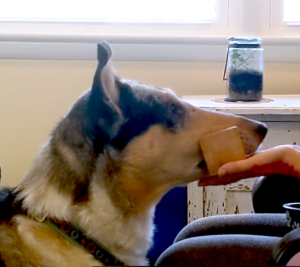When training a service dog to retrieve, the last component of the behavior is the give: having the dog deliver the item to the handler’s hand. This component often goes smoothly in a training context. However, when the handler needs the dog to perform in real-world contexts, the dog may drop the item before the person has been able to secure it. Here are four simple strategies to troubleshoot this common challenge:
1. Adjust your hand movement during the training process.
Trainers often move their hand toward the dog when the dog brings the item to them. The dog learns to stop moving early and wait for the handler to reach toward the dog. Depending on the person’s disability, they may not be able to move their hand toward the dog in a real-life situation. Alternatively, their hand movement may be slower or not as coordinated. Watch how your client moves their hand, and then move your hand the same way during the training process so the dog learns to deliver items in a way that the client can secure them.
2. Incorporate a chin rest into the training process.
When teaching the hold, trainers sometimes teach the dog to drop items when releasing them, for instance by placing their hand under the dog’s mouth and then cuing the dog to release. However, in some cases, the dog learns to begin to release the instant the person’s hand starts to move toward the dog. If the client’s disability makes it harder for them to move their hand quickly or accurately under the dog’s mouth, the item can fall.
A better strategy is to teach the dog to place the item directly into the person’s hand. One way to teach this is by incorporating a chin rest in the training process. Practice cuing the hold, and then cue the chin rest while the item is still in the dog’s mouth. When the dog performs this reliably, put the sequence together with picking up the item from the floor and bringing it to you. Then cue the chin rest (while the dog is holding), and finally cue the dog to release.
3. Practice the retrieve in different orientations relative to the dog.
We tend to face dogs when working on task training. However, in the real world, the service dog may be delivering items in various positions relative to the handler. There may even be items in the way, such as furniture or store shelves, that limit the dog’s movement. An important aspect of generalizing the retrieve behavior is to practice this skill in many orientations and positions with items of different shapes and sizes. Keep in mind that you need to consider both the handler’s disability and the dog’s movement in the training process here as well. In some cases, the individual’s disability may limit their range of motion, in which case the dog may need to reach to ensure the item ends up in their hand.
4. Adjust the training process for a handler using a wheelchair if needed.
When a service dog is delivering items to a person in a wheelchair, the foot plates, arm rest and the person’s knees all may make it more difficult for the dog to deliver the item. The height of the wheelchair itself can be an additional variable in the training process. Much of the time, simply holding your own hand higher up when receiving items during the training process helps the dog learn to move their head higher when delivering the item. However, if the dog is short or if the handler’s wheelchair is very tall, then some additional changes to the training process may be needed. In some cases, the wheelchair footrests may be sturdy enough to support the dog’s weight without moving the chair itself, in which case the dog can be trained to step on them as a small platform to deliver the item. Alternatively, it may be more effective to teach the dog to deliver the item to the person’s lap rather than their hands.
Ideally, problems with the give component of the retrieve will be prevented by teaching the behavior in a way that accounts for the handler’s disability early in the training process. That way the training strategies can be adapted to avoid the dog being reinforced for releasing the item in a way that makes it difficult for the handler to secure it. As is true for any service dog task, taking some time to learn how a client’s disability impacts their movements can be important when teaching the retrieve, and it will set both dog and handler up for success.
Learn more strategies to teach the retrieve in our on-demand course, The Retrieve the Essential Service Dog Task.

